Energy Savings from Optimised In-Field Route Planning for Agricultural Machinery
Abstract
:1. Introduction
2. Materials and Methods
- The covering of the headland area has been excluded from the comparison, and only the covering of the main field area has been considered.
- All the operations are executed continuously without any load capacity restriction.
- During the turnings the fuel consumption is considered to be the same as the one during the operation.
- The energy consumption for the material transportation is not considered in the comparison.
- The energy consumption for the machinery transportation from farm to field is not considered in the comparison.
- It has been considered that the field entrance can be anywhere in the field boundary.
2.1. Field Shapes
2.2. Cropping Systems
2.3. Machinery Systems
2.4. Energy Inputs
2.5. The Assessment Model
3. Results and Discussion
3.1. Time Requirements
3.2. Energy Cost Analysis
3.3. The Effect of Machinery Size
4. Conclusions
Acknowledgments
Author Contributions
Conflicts of Interest
References
- Bochtis, D.D.; Sørensen, C.G.; Busato, P. Advances in agricultural machinery management: A review. Biosyst. Eng. 2014, 126, 69–81. [Google Scholar] [CrossRef]
- Sørensen, C.G.; Bochtis, D.D. Conceptual model of fleet management in agriculture. Biosyst. Eng. 2010, 105, 41–50. [Google Scholar] [CrossRef]
- Sørensen, C.G.; Fountas, S.; Nash, E.; Pesonen, L.; Bochtis, D.; Pedersen, S.M.; Basso, B.; Blackmore, S.B. Conceptual model of a future farm management information system. Comput. Electron. Agric. 2010, 72, 37–47. [Google Scholar] [CrossRef]
- Van Zuydam, R.P.; Sonneveld, C. Test of an automatic precision guidance system for cultivation implements. J. Agric. Eng. Res. 1994, 59, 239–243. [Google Scholar] [CrossRef]
- Kaivosoja, J.; Linkolehto, R. GNSS error simulator for farm machinery navigation development. Comput. Electron. Agric. 2015, 119, 166–177. [Google Scholar] [CrossRef]
- Carballido, J.; Perez-Ruiz, M.; Emmi, L.; Agüera, J. Comparison of positional accuracy between rtk and rtx gnss based on the autonomous agricultural vehicles under field conditions. Appl. Eng. Agric. 2014, 30, 361–366. [Google Scholar]
- Batte, M.T.; Ehsani, M.R. The economics of precision guidance with auto-boom control for farmer-owned agricultural sprayers. Comput. Electron. Agric. 2006, 53, 28–44. [Google Scholar] [CrossRef]
- Chesworth, W. Encyclopedia of Soil Science; Springer: Dordrecht, The Netherlands, 2008. [Google Scholar]
- Oksanen, T.; Visala, A. Coverage path planning algorithms for agricultural field machines. J. Field Robot. 2009, 26, 651–668. [Google Scholar] [CrossRef]
- Jin, J.; Tang, L. Optimal coverage path planning for arable farming on 2D surfaces. Trans. ASABE 2010, 53, 283–295. [Google Scholar] [CrossRef]
- Scheuren, S.; Stiene, S.; Hartanto, R.; Hertzberg, J.; Reinecke, M. Spatio-temporally constrained planning for cooperative vehicles in a harvesting scenario. KI Künstliche Intell. 2013, 27, 341–346. [Google Scholar] [CrossRef]
- Bochtis, D.D.; Sørensen, C.G. The vehicle routing problem in field logistics part I. Biosyst. Eng. 2009, 104, 447–457. [Google Scholar] [CrossRef]
- Jensen, M.F.; Bochtis, D.; Sørensen, C.G. Coverage planning for capacitated field operations, part II: Optimisation. Biosyst. Eng. 2015, 139, 149–164. [Google Scholar] [CrossRef]
- Zhou, K.; Leck Jensen, A.; Sørensen, C.G.; Busato, P.; Bochtis, D.D. Agricultural operations planning in fields with multiple obstacle areas. Comput. Electron. Agric. 2014, 109, 12–22. [Google Scholar] [CrossRef]
- Jin, J.; Tang, L. Coverage path planning on three-dimensional terrain for arable farming. J. Field Robot. 2011, 28, 424–440. [Google Scholar] [CrossRef]
- Seyyedhasani, H.; Dvorak, J.S. Using the Vehicle Routing Problem to reduce field completion times with multiple machines. Comput. Electron. Agric. 2017, 134, 142–150. [Google Scholar] [CrossRef]
- Conesa-Muñoz, J.; Bengochea-Guevara, J.M.; Andujar, D.; Ribeiro, A. Route planning for agricultural tasks: A general approach for fleets of autonomous vehicles in site-specific herbicide applications. Comput. Electron. Agric. 2016, 127, 204–220. [Google Scholar] [CrossRef]
- Bochtis, D.D.; Vougioukas, S.G. Minimising the non-working distance travelled by machines operating in a headland field pattern. Biosyst. Eng. 2008, 101, 1–12. [Google Scholar] [CrossRef]
- Bochtis, D.D.; Sørensen, C.G.; Busato, P.; Berruto, R. Benefits from optimal route planning based on B-patterns. Biosyst. Eng. 2013, 115, 389–395. [Google Scholar] [CrossRef]
- Bochtis, D.D.; Vougioukas, S.G.; Griepentrog, H.W. A mission planner for an autonomous tractor. Trans. ASABE 2009, 52, 1429–1440. [Google Scholar] [CrossRef]
- De Bruin, S.; Lerink, P.; Klompe, A.; van der Wal, T.; Heijting, S. Spatial optimisation of cropped swaths and field margins using GIS. Comput. Electron. Agric. 2009, 68, 185–190. [Google Scholar] [CrossRef]
- Witney, B. Choosing and Using Farm Machines; Longman Scientific & Technical: Harlow, UK, 1988. [Google Scholar]
- Angelini, LG.; Ceccarini, L.; Nassi o Di Nasso, N.; Bonari, E. Comparison of Arundo donax L. and Miscanthus x giganteus in a long-term field experiment in Central Italy: Analysis of productive characteristics and energy balance. Biomass Bioenergy 2009, 33, 635–643. [Google Scholar] [CrossRef]
- DEFRA. Planting and Growing Miscanthus; DEFRA Crop Energy Branch: London, UK, 2007.
- Bassam, N.E. Handbook of Bioenergy Crops: A Complete Reference to Species, Development and Applications; Earthscan: London, UK, 2010. [Google Scholar]
- Piscioneri, I.; Pignatelli, V.; Palazzo, S.; Sharma, N. Switchgrass production and establishment in the Southern Italy climatic conditions. Energy Convers. Manag. 2001, 42, 2071–2082. [Google Scholar] [CrossRef]
- Atkinson, C.J. Establishing perennial grass energy crops in the UK: A review of current propagation options for Miscanthus. Biomass Bioenergy 2009, 33, 752–759. [Google Scholar] [CrossRef]
- Saunders, C.; Barber, A.; Taylor, G. Food Miles—Comparative Energy/Emissions Performance of New Zealand’s Agriculture Industry; Research Report No. 285; Lincoln University: Lincoln, New Zealand, 2006. [Google Scholar]
- ASAE. D497.4: Agricultural Machinery Management Data. In ASABE Stabdards; American Society of Agricultural Engineers (ASAE): St. Joseph, MI, USA, 2003. [Google Scholar]
- ASABE. D497.7: Agricultural Machinery Management Data. In ASABE Standards; American Society of Agricultural and Biological Engineers (ASABE): St. Joseph, MI, USA, 2011. [Google Scholar]
- Kitani, O. CIGR Handbook of Agricultural Engineering Volume V; CIGR–The I.; ASAE Publication: St. Joseph, MI, USA, 1999; Volume V. [Google Scholar]
- Wells, C. Total Energy Indicators of Agricultural Sustainability: Dairy Farming Case Study; Technical Paper 2001/3; Ministry of Agriculture and Forestry: Wellington, New Zealand, 2001.
- Clarke, G.; Wright, J.W. Scheduling of vehicles from a central depot to a number of delivery points. Oper. Res. 1964, 12, 568–581. [Google Scholar] [CrossRef]
- Sopegno, A.; Rodias, E.; Bochtis, D.; Busato, P.; Berruto, R.; Boero, V.; Sørensen, C. Model for energy analysis of Miscanthus production and transportation. Energies 2016, 9, 392. [Google Scholar] [CrossRef]
- Rodias, E.; Berruto, R.; Bochtis, D.; Busato, P.; Sopegno, A. A computational tool for comparative energy cost analysis of multiple-crop production systems. Energies 2017, 10, 831. [Google Scholar] [CrossRef]
- Cavallo, E.; Ferrari, E.; Bollani, L.; Coccia, M. Attitudes and behaviour of adopters of technological innovations in agricultural tractors: A case study in Italian agricultural system. Agric. Syst. 2014, 130, 44–54. [Google Scholar] [CrossRef]
- Läpple, D.; Renwick, A.; Thorne, F. Measuring and understanding the drivers of agricultural innovation: Evidence from Ireland. Food Policy 2015, 51, 1–8. [Google Scholar] [CrossRef]
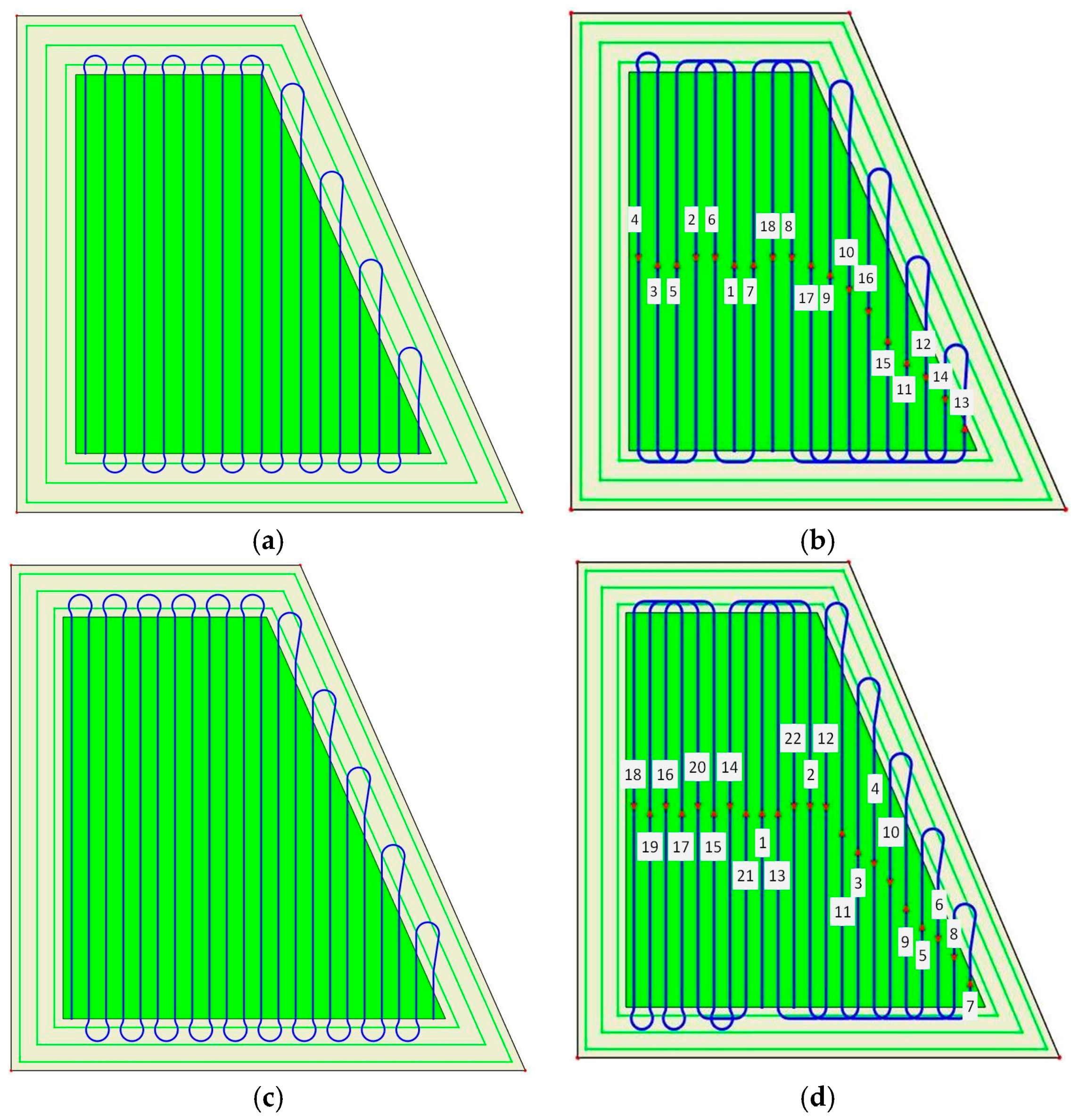
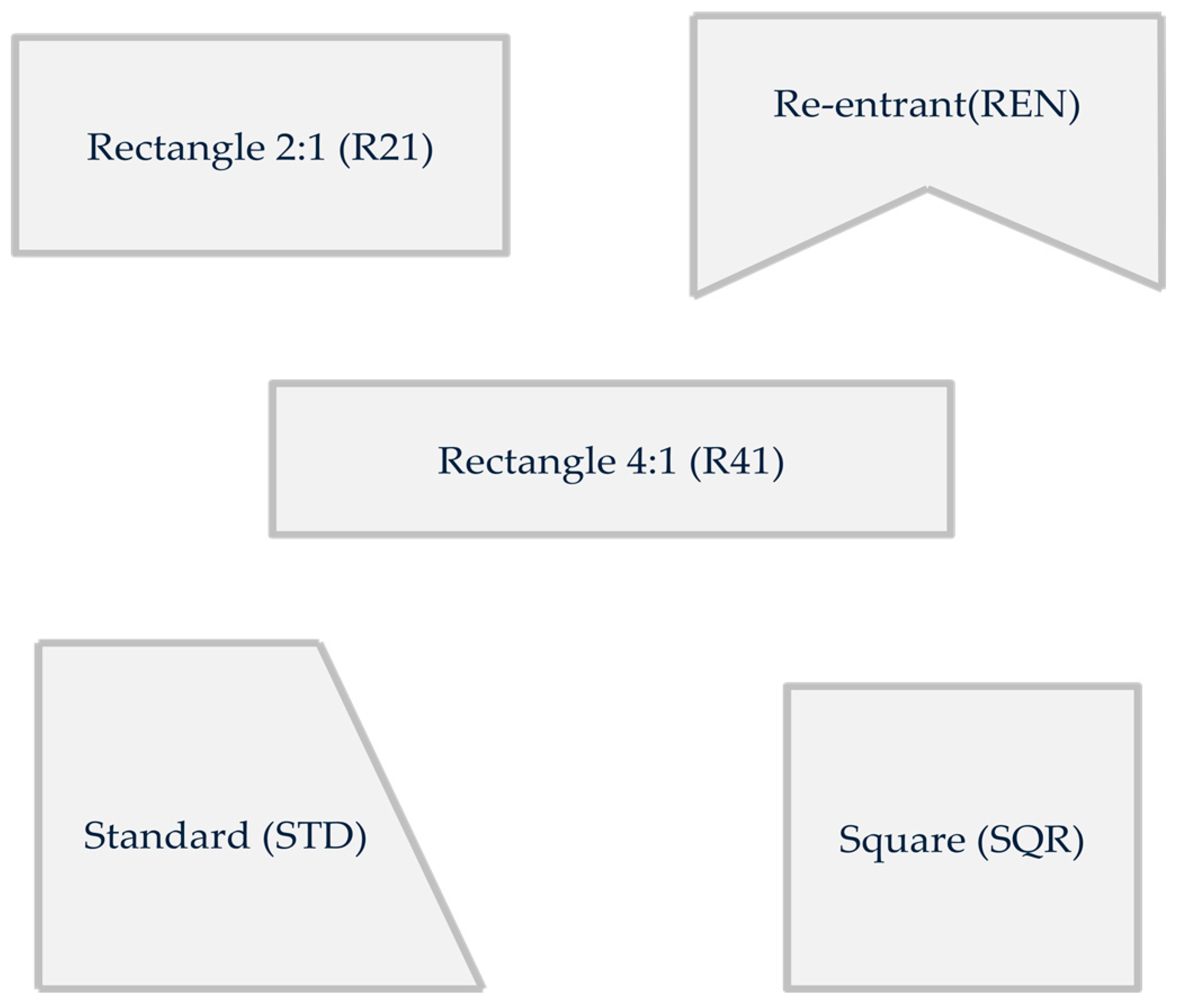


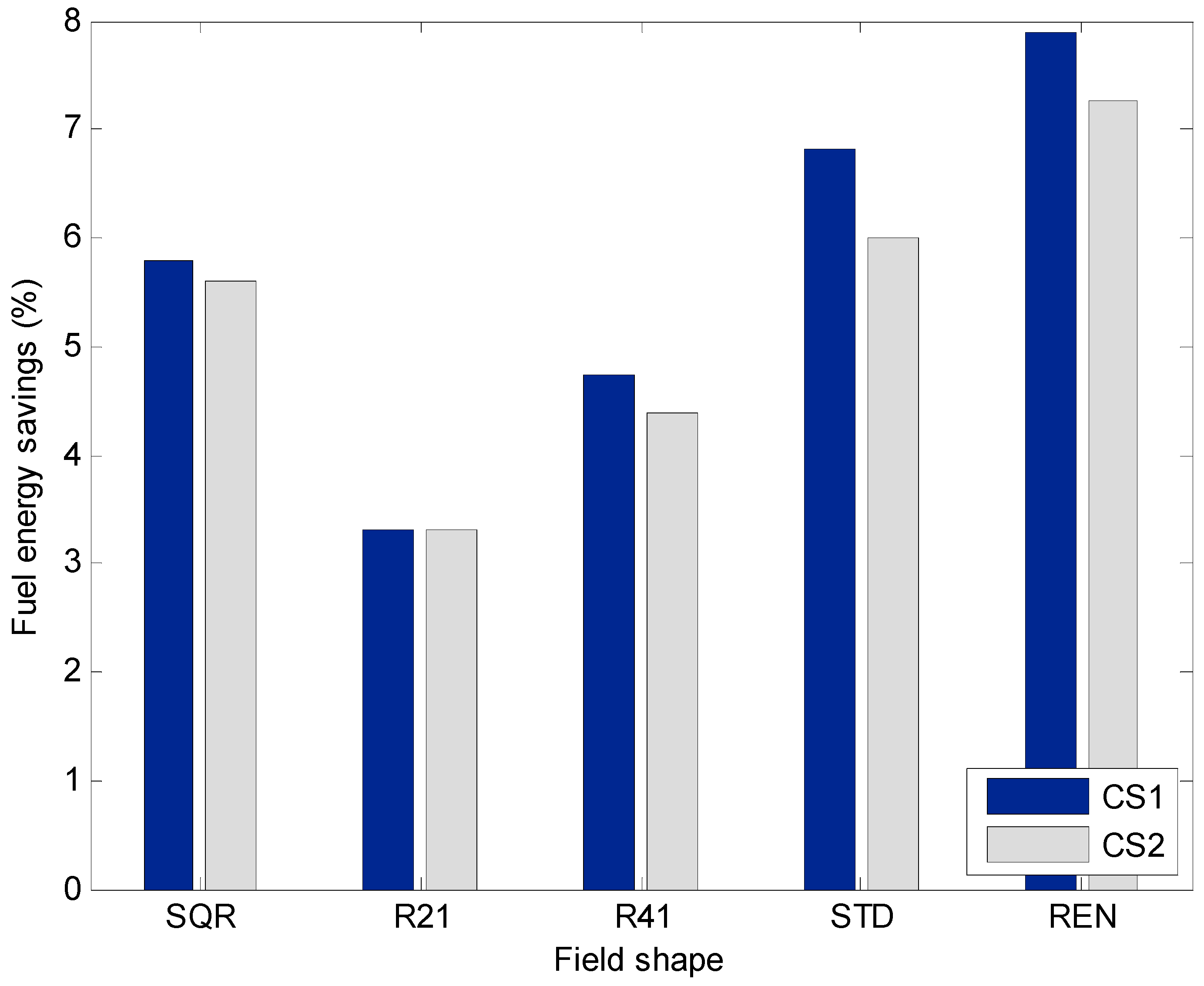

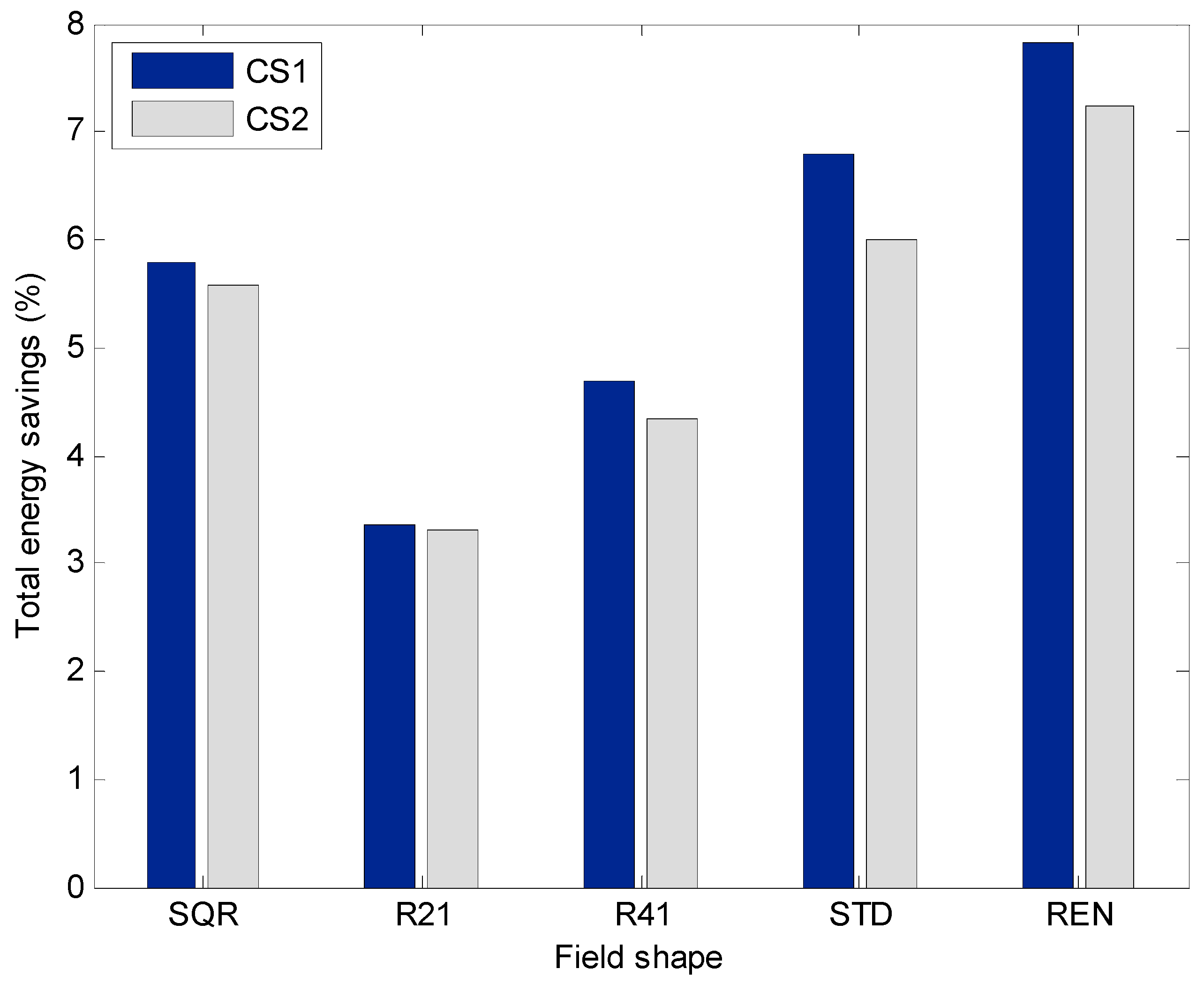
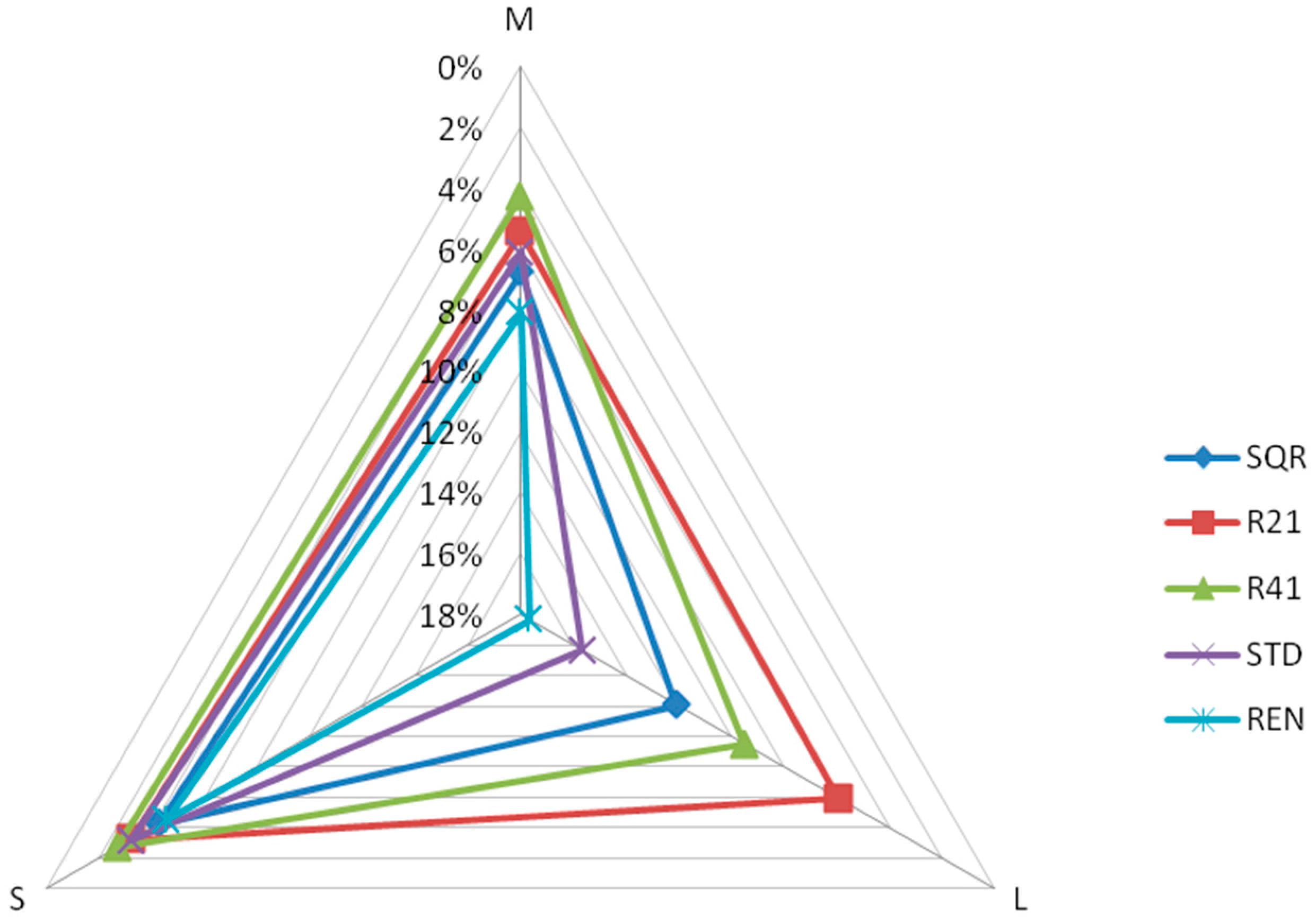
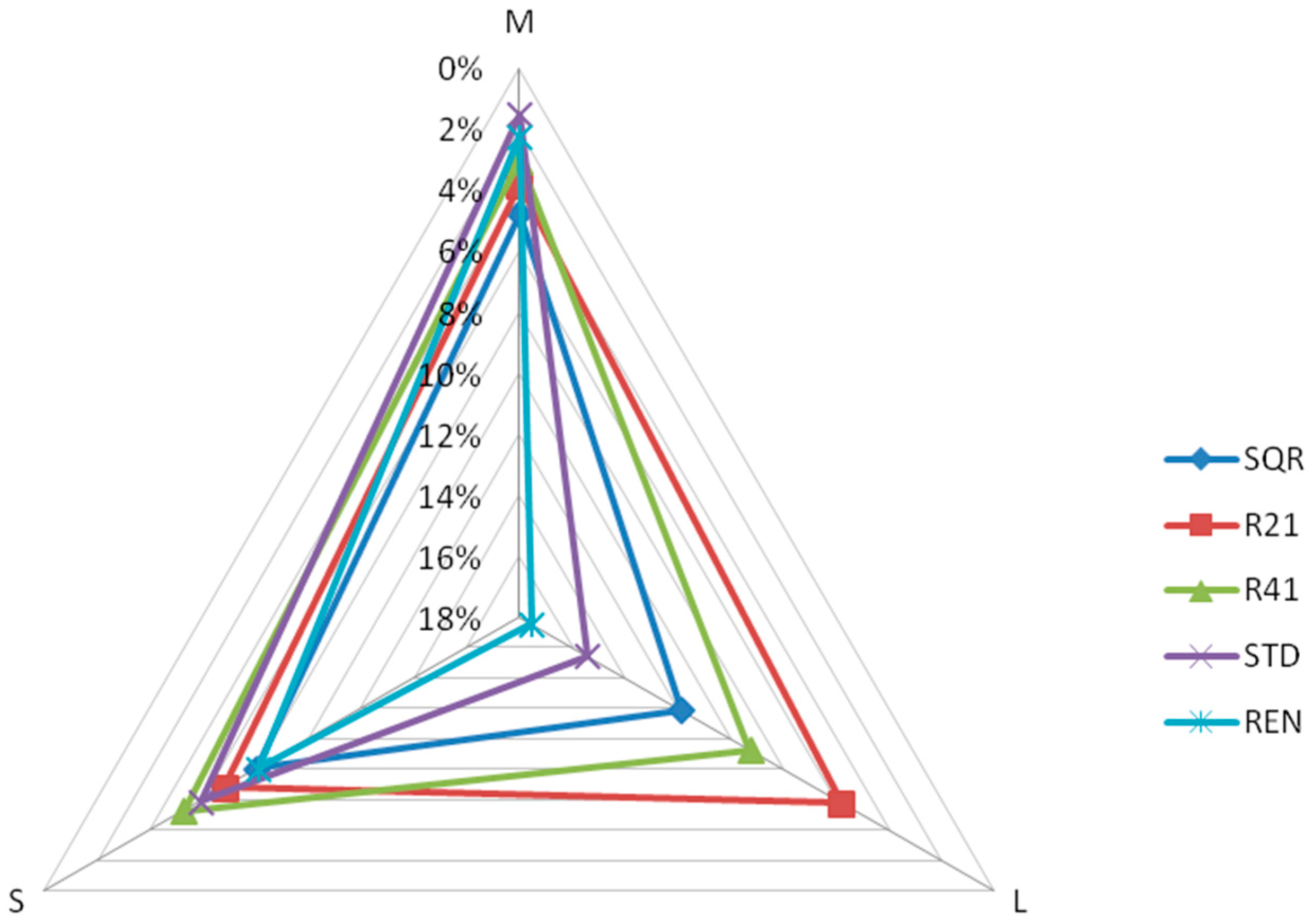
| Ploughing | Disk-Harrow | Planting | Spreading | Mowing | Harvesting | ||
|---|---|---|---|---|---|---|---|
| Operating width (m) | CS1 | 3 | 4.5 | 3 | 12 | - | 3 |
| CS2 | 3 | 6 | 4.5 | 10.5 | 3 | 3 | |
| Minimum turning radius (m) | CS1 | 6 | 4.5 | 3 | 6 | - | 6 |
| CS2 | 6 | 4.5 | 3 | 6 | 3 | 6 | |
| Operating speed (m/s) | CS1/CS2 | 2 | 2.8 | 2.5 | 3 | 3 | 1.4 |
| Tractor Embodied Energy 1 (MJ·kg−1) | Implement Embodied Energy 1 (MJ·kg−1) | Tractor Mass 2 (103 kg) | Implement Mass 3 (103 kg) | Tractor Estimated Life 4 (103 h) | Implement Estimated Life 4 (103 h) | Tractor Power (kW) | |
|---|---|---|---|---|---|---|---|
| Plough | 138 | 180 | 10 | 2.30 | 16 | 2 | 180 |
| Disk-harrow | 138 | 149 | 6.76 | 1.80 | 16 | 2 | 120 |
| Spreading | 138 | 129 | 10 | 3.35 | 16 | 1.2 | 180 |
| Planting/Seeding | 138 | 133 | 2.93 | 1.20 | 12 | 1.5 | 50 |
| Mowing | 138 | 110 | 6.76 | 0.65 | 16 | 2 | 120 |
| Harvesting | 138 | 116 | 10 | 0.90 | 16 | 2.5 | 180 |
| Field Shape | Case Study | Field Route Planning | Ploughing | Disk-Harrow | Planting | Spreader | Mower | Harvesting |
|---|---|---|---|---|---|---|---|---|
| SQR | CS1 | Non-optimised | 33.3 | 15.7 | 24.7 | 5.8 | - | 46.0 |
| Optimised | 31.2 | 14.6 | 23.4 | 5.6 | - | 43.3 | ||
| CS2 | Non-optimised | 33.3 | 11.8 | 16.7 | 6.7 | 20.3 | 45.8 | |
| Optimised | 31.3 | 11.2 | 16.2 | 6.3 | 19.3 | 43.2 | ||
| R21 | CS1 | Non-optimised | 32.1 | 15.1 | 24.5 | 5.7 | - | 44.2 |
| Optimised | 31.0 | 14.2 | 23.5 | 5.5 | - | 43.0 | ||
| CS2 | Non-optimised | 32.1 | 11.4 | 16.2 | 6.4 | 20.2 | 44.1 | |
| Optimised | 30.9 | 10.9 | 15.7 | 6.0 | 19.4 | 43.2 | ||
| R41 | CS1 | Non-optimised | 31.6 | 15.0 | 24.3 | 5.6 | - | 44.1 |
| Optimised | 30.8 | 14.3 | 23.5 | 5.4 | - | 41.2 | ||
| CS2 | Non-optimised | 31.6 | 11.6 | 16.2 | 6.4 | 20.0 | 44.1 | |
| Optimised | 30.8 | 11.3 | 15.9 | 6.1 | 19.4 | 41.1 | ||
| STD | CS1 | Non-optimised | 33.8 | 16.2 | 24.7 | 5.6 | - | 46.6 |
| Optimised | 31.4 | 14.6 | 23.7 | 5.4 | - | 43.6 | ||
| CS2 | Non-optimised | 33.7 | 11.5 | 16.3 | 6.4 | 20.3 | 46.5 | |
| Optimised | 30.6 | 11.3 | 16.0 | 6.2 | 19.5 | 43.5 | ||
| REN | CS1 | Non-optimised | 35.1 | 15.9 | 25.0 | 5.7 | - | 48.4 |
| Optimised | 31.9 | 14.6 | 23.6 | 5.6 | - | 44.3 | ||
| CS2 | Non-optimised | 35.1 | 11.8 | 16.5 | 6.5 | 20.6 | 48.4 | |
| Optimised | 31.9 | 11.5 | 16.0 | 6.2 | 19.4 | 44.1 |
| Field Shape | Case Study | Ploughing | Disk-Harrow | Planting | Spreader | Harvesting | Mowing |
|---|---|---|---|---|---|---|---|
| SQR | CS1 | 6.25 | 7.07 | 5.09 | 3.92 | 5.76 | - |
| CS2 | 6.25 | 5.20 | 3.21 | 5.81 | 5.76 | 5.15 | |
| R21 | CS1 | 3.61 | 5.70 | 3.93 | 4.55 | 2.16 | - |
| CS2 | 3.61 | 4.20 | 2.90 | 6.32 | 2.16 | 4.20 | |
| R41 | CS1 | 2.57 | 4.54 | 3.14 | 3.60 | 6.85 | - |
| CS2 | 2.57 | 3.19 | 2.11 | 4.49 | 6.85 | 3.23 | |
| STD | CS1 | 9.18 | 6.57 | 3.95 | 2.83 | 6.52 | - |
| CS2 | 9.19 | 1.70 | 2.13 | 3.81 | 6.52 | 3.91 | |
| REN | CS1 | 9.04 | 8.49 | 5.51 | 1.20 | 8.82 | - |
| CS2 | 9.04 | 2.29 | 2.70 | 3.96 | 8.82 | 5.83 |
| Field Shape | Case Study | Ploughing | Disk-Harrow | Planting | Spreader | Harvesting | Mowing |
|---|---|---|---|---|---|---|---|
| SQR | CS1 | 6.25 | 7.09 | 5.07 | 3.90 | 5.76 | - |
| CS2 | 6.25 | 5.22 | 3.23 | 5.83 | 5.76 | 5.16 | |
| R21 | CS1 | 3.60 | 5.69 | 3.92 | 4.56 | 2.16 | - |
| CS2 | 3.61 | 4.20 | 2.89 | 6.15 | 2.16 | 4.21 | |
| R41 | CS1 | 2.57 | 4.53 | 3.14 | 3.59 | 6.85 | - |
| CS2 | 2.57 | 3.19 | 2.14 | 4.60 | 6.85 | 3.22 | |
| STD | CS1 | 9.18 | 6.57 | 3.96 | 2.81 | 6.52 | - |
| CS2 | 9.19 | 1.69 | 2.15 | 3.74 | 6.53 | 3.93 | |
| REN | CS1 | 9.04 | 8.50 | 5.50 | 1.21 | 8.82 | - |
| CS2 | 9.04 | 2.31 | 2.66 | 3.87 | 8.83 | 5.84 |
© 2017 by the authors. Licensee MDPI, Basel, Switzerland. This article is an open access article distributed under the terms and conditions of the Creative Commons Attribution (CC BY) license (http://creativecommons.org/licenses/by/4.0/).
Share and Cite
Rodias, E.; Berruto, R.; Busato, P.; Bochtis, D.; Sørensen, C.G.; Zhou, K. Energy Savings from Optimised In-Field Route Planning for Agricultural Machinery. Sustainability 2017, 9, 1956. https://doi.org/10.3390/su9111956
Rodias E, Berruto R, Busato P, Bochtis D, Sørensen CG, Zhou K. Energy Savings from Optimised In-Field Route Planning for Agricultural Machinery. Sustainability. 2017; 9(11):1956. https://doi.org/10.3390/su9111956
Chicago/Turabian StyleRodias, Efthymios, Remigio Berruto, Patrizia Busato, Dionysis Bochtis, Claus Grøn Sørensen, and Kun Zhou. 2017. "Energy Savings from Optimised In-Field Route Planning for Agricultural Machinery" Sustainability 9, no. 11: 1956. https://doi.org/10.3390/su9111956






